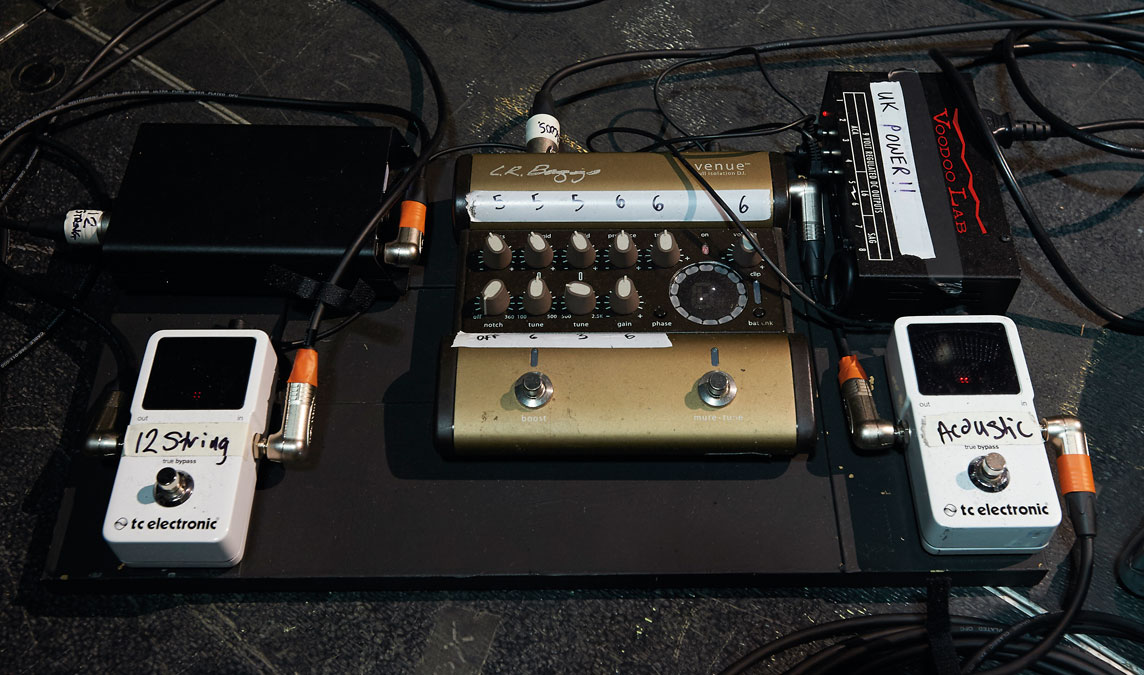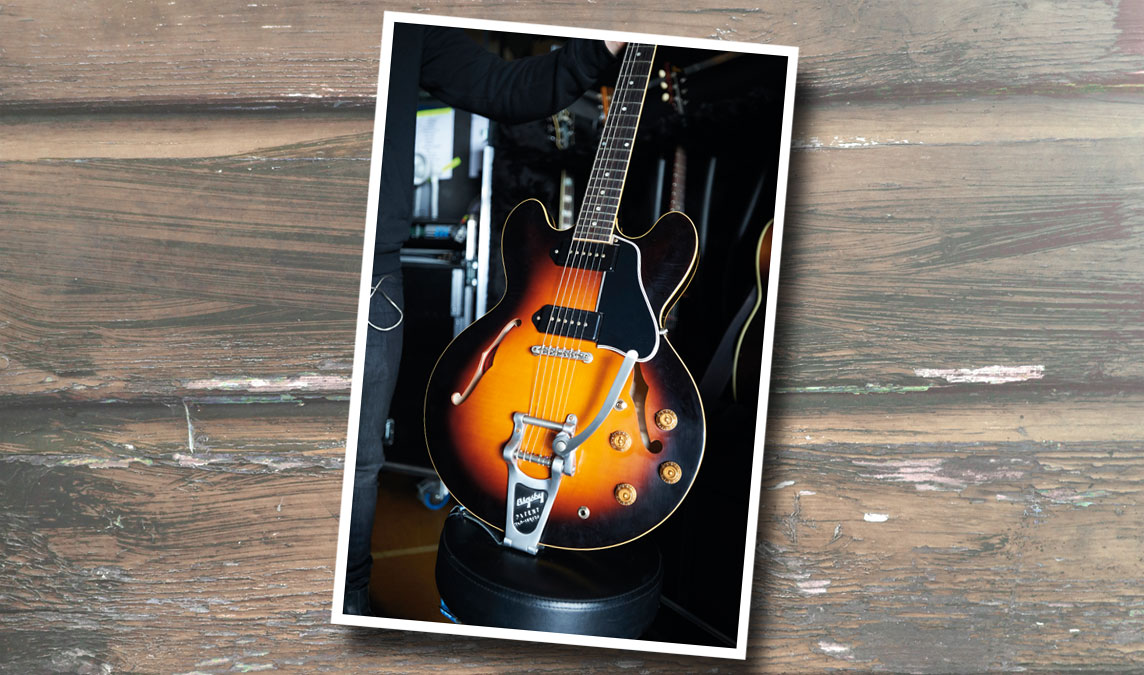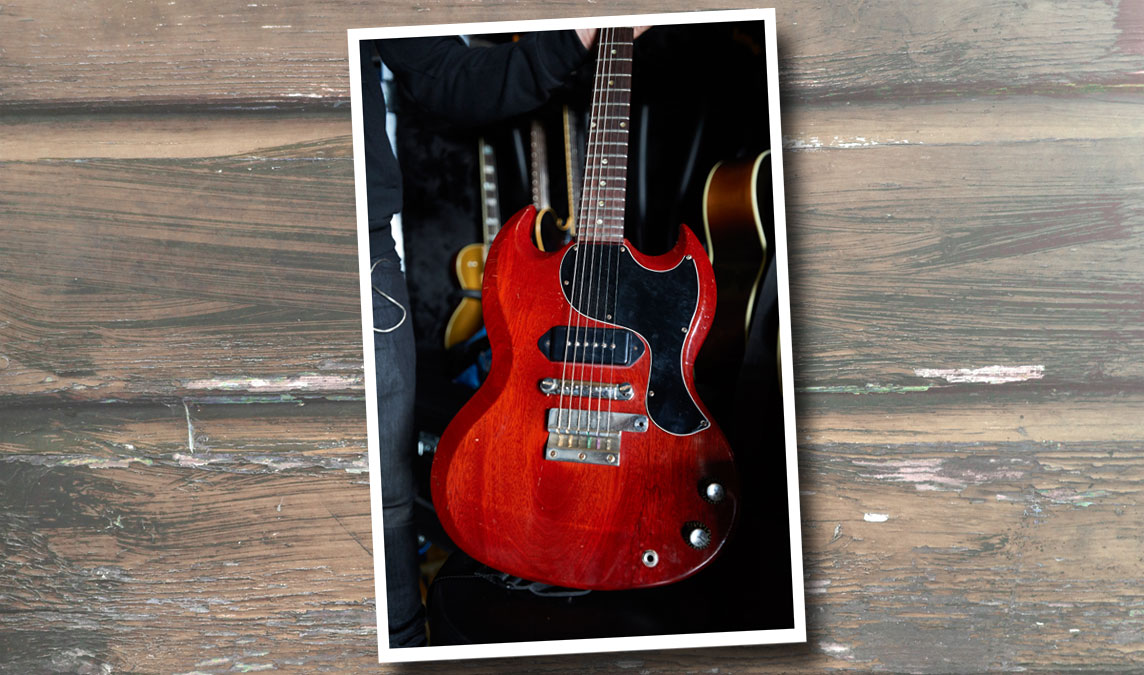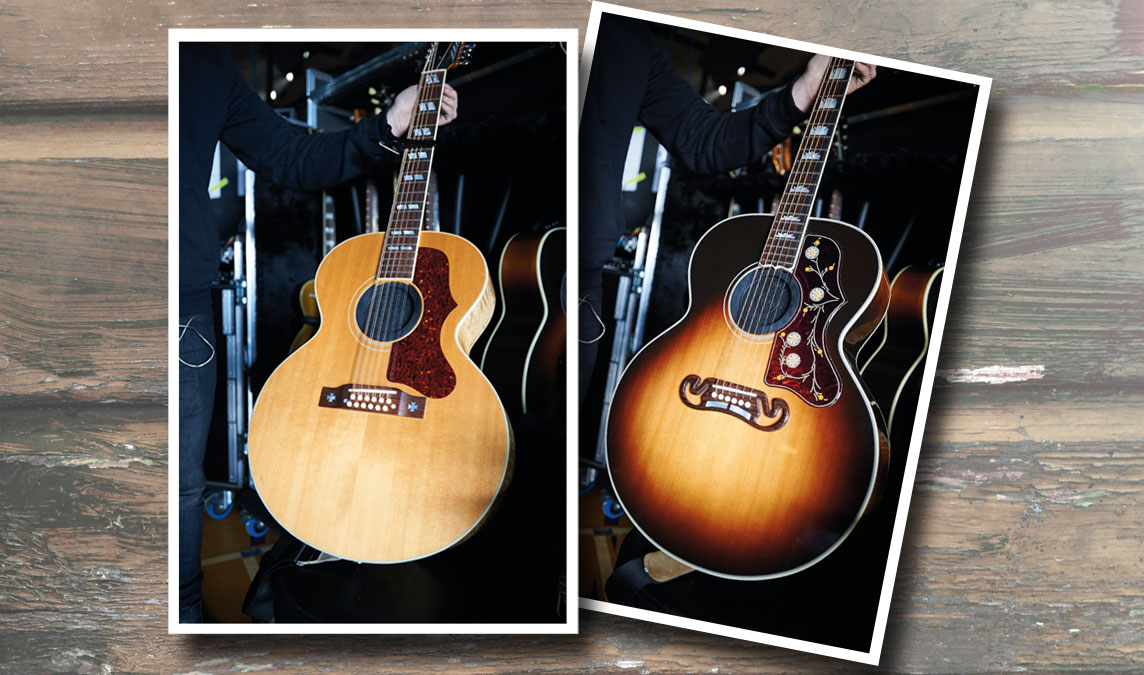James Bay talks Epiphone Centurys and 'blagging being a singer songwriter'
In-depth with the man of the moment
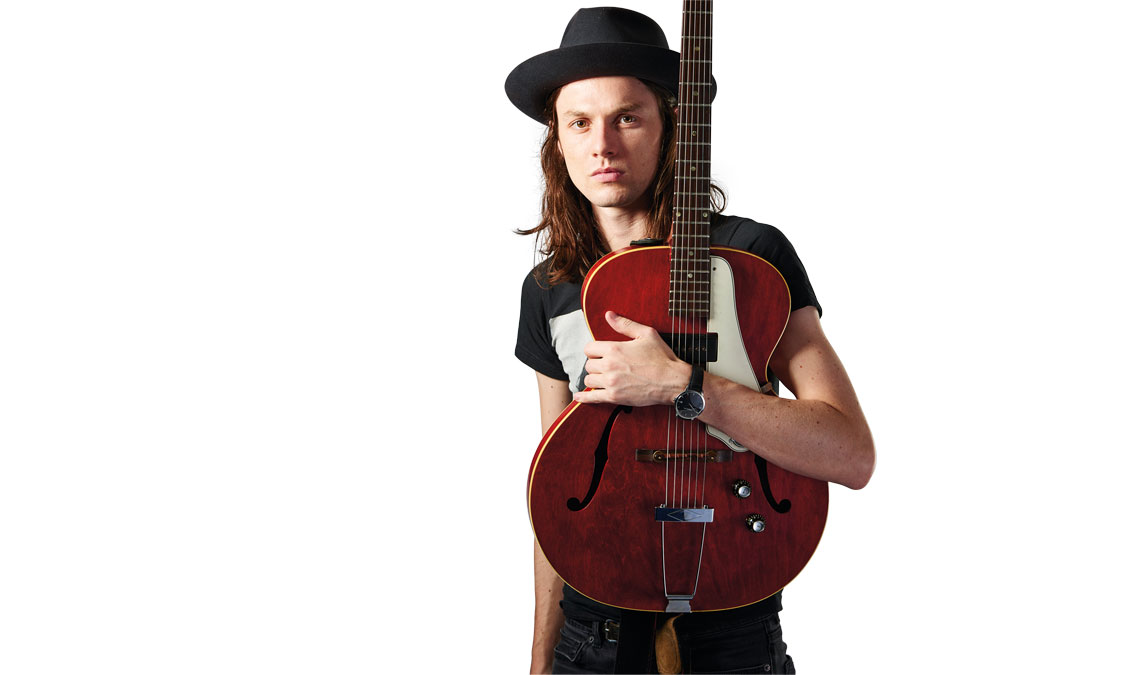
Introduction
James Bay’s heart-melting voice and hit-happy songwriting have taken him from the UK open- mic circuit to world tours, a platinum record and a string of prestigious awards. Rumour has it he can play guitar a bit, too...
The busy pre-show bustle of James Bay’s European tour machine is in full swing. Band members thumb smartphones for catering arrangements and soundcheck times, as crew dangle precariously from ceiling and scaffold to hang lights and fly speakers.
I started out as a guitar player and under my skin, at the end of the day, that’s who I am
Backstage, our main man is throwing poses for TG’s photographer, Joe, ’66 Epiphone Century slung between Dr Martens Chelsea boots and the customary wide-brimmed fedora. Shortly afterwards, we venture front-of-house for soundcheck.
Wailing, bluesy P-90 goodness echoes around the empty auditorium - Bay is clearly the accomplished six-string slinger when he chooses to let loose. On stage there are a total of five guitar amps; one each for guitarist, Andy Cortes and keys/guitar man, Jack Duxbury, but the remaining three - yes three - find themselves on the end of Mr Bay’s cable. Serious guitar player? You better believe it.
“I’m doing a great job of blagging being a singer and a songwriter,” laughs Bay as we get chatting after soundcheck and delve into his guitar-playing past.
“I started out as a guitar player and under my skin, at the end of the day, that’s who I am. As cool as everything else is,” he continues, referring to his mainstream success, awards and so on.
When Ronnie Wood comes on stage at Brixton. At your gig. That’s unreal, it’s a mad old thing
“One of the coolest things is that over this year, gradually more guitar players get my music. From some corner of the venue, crowd, car park or whatever, someone pops out and says, ‘Hey man, the guitar was killer tonight’. And the little 11 year-old me in my head loses his mind. I would never be here without the guitar.”
So how does it feel, to have come so far so quickly? “It feels great, I have to say,” he replies candidly. “I’m still surprised, because as a kid before I started playing the guitar, I was quite shy. I still am, but now it feels like the thing I’ve always wanted to do.
“When I was nine and I was watching Michael Jackson’s Moonwalker, or Eric Clapton Unplugged, Queen at Live Aid or whatever, I would daydream about what it was like to be on that stage, like anybody would. And I’d run up to my room later on, put a record on and dance in front of the mirror. Now, it’s outrageous. Like when Ronnie Wood comes on stage at Brixton. At your gig. That’s unreal, it’s a mad old thing.”
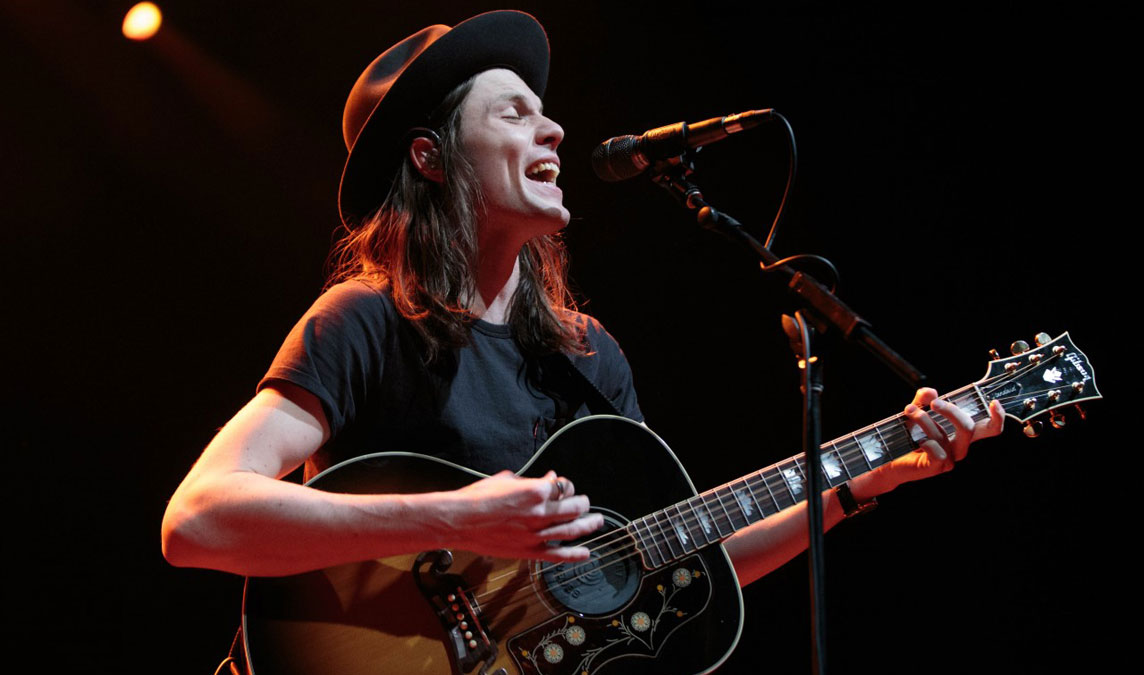
Open-mic memories
Bay’s rise to stardom has been swift by any measure, yet rare is the musician who simply appears on the world stage without a lots-of-hard-work backstory. What was he doing five years ago?
“I was wandering around being very acoustic, writing songs, and I’d sent myself off to guitar Shawshank Redemption,” he laughs.
“I couldn’t really play electrics because in my mind, I hadn’t written songs good enough for them. I’d grown up widdling away on electric guitars to Clapton’s From The Cradle, Joe Cocker’s Mad Dogs & Englishmen, to Exile On Main St, Texas Flood… I drowned myself in all that to the point where I needed to come back to the surface and rediscover music again for something different. And that was for songs.
I was learning. I’d take my songs to those nights and find out if people would shut up when they listened to them
“I was kinda pulling my hair out trying to write better and better songs,” he continues. “Songs that people wanted to listen to and hear again and again, and wanted to sing along to in a pub, in a club and in a venue.
“I felt that if I couldn’t write a great song on an acoustic guitar and perform it with just that and my voice, then I couldn’t move forward in music. I was wandering around the world - well, England (laughs) - with an acoustic guitar, playing open-mic nights, writing, working and learning.”
That can be a thankless experience, presumably - winning over audiences that are there to just see their own mates, more often than not?
“Sometimes,” he acknowledges. “But I was learning. I’d take my songs to those nights with my acoustic guitar and find out if people would shut up when they listened to them. And if they didn’t, I’d go away and work on them. If they listened to the chorus but not the second verse and the second chorus, that chorus clearly wasn’t good enough and needed to be better. So I’d work on it.”
That’s a very different approach from the vast majority of songwriters, we suggest, and it takes a lot of guts and humility to be critical of your own work?
I got away with selling an EP for £1 for a little bit, then it had to become free just to get rid of some
“Well it’s easy to be indulgent,” concurs Bay, latching onto our subtext. “It’s easy to just say, ‘I think this is the greatest thing I’ve ever done and probably the best thing anyone’s heard.’ Well ‘probably’ isn’t sure enough. It’s not me that’s going to buy my album 200,000 times. I don’t have enough money! I need hundreds of thousands of other people to want to buy it, so I had to write good enough songs.”
And what about work during all this writing - what was paying the bills? “A million bar jobs,” he sighs. “Bar after bar, getting fired or being asked to leave because I clearly wasn’t into it. And I wasn’t, I was just trying to make some money to get into London, because there were some half-decent open-mics going on there.
“I’d spent a couple of years in Brighton having a great time, learning, doing that same thing of finding out what works in front of an audience and what doesn’t. I went back to Hitchin where I grew up and worked in a load of bars… but I’m not interested in being in bars unless I’m playing to some people that wanted to buy my £1 EP.
“I got away with selling an EP for £1 for a little bit, then it had to become free just to get rid of some. So yeah, working a bit, but all other hours of the day and night were writing, and second guessing the hell out of every single idea!”
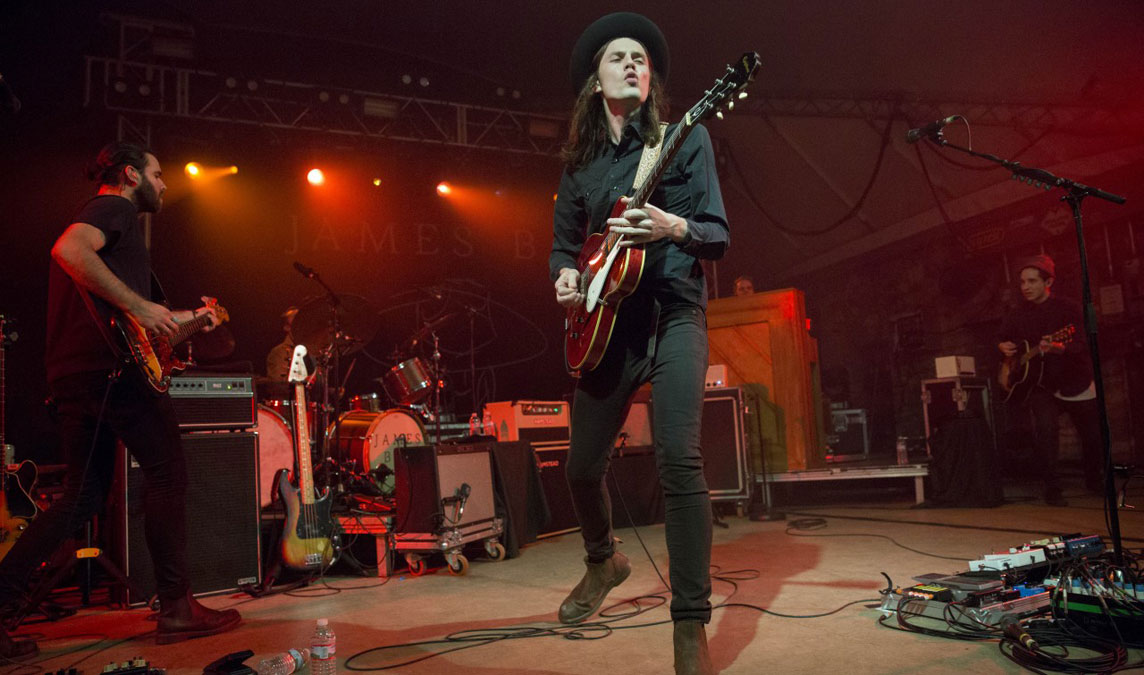
My rodeo
Throughout Bay’s rise from open-mic success to award-winning artist and songwriter, his childhood friend Tom Peel has been very much part of the picture. Taking predominantly bass duties these days, the two have known each other since primary school. Musical brothers, perhaps?
“Thanks for asking about that,” beams Bay, always eager to big-up his bandmates. “We’ve grown up together, very much grown up musically together. Somehow we’ve always been mates and we’d bonded on things before guitar, before music,” he continues.
I want to be like The Stones: I want to call the shots. You’ve got to know when to dig your heels in
“Then it was all 10 times bigger once we’d both fallen in love with guitar. We sat there with our six-string guitars with a load of other mates and said, ‘Let’s start a band’ and said to Tom, ‘D’you fancy playing the bass?’ He’s a trooper, he said yes and we all know that the guy who says yes might well end up being the bass player forever. He plays guitar on the recordings, and also on one song live; he’s a guitar player/bass player and it totally works.
“So 50 per cent of it is that and 50 per cent of it is that he’s my best mate. If it looks like you’re going to have to travel around the world, hopefully for the rest of your life, you want somebody like that by your side. And I have to tell you, he just bought a gorgeous ’62 [Gibson] EB-2 in Brighton the other day. We all chipped in our PDs [per diem, per-day living expenses when on tour] to get it.”
We ask about the growing pains and compromises of increasing success. Had Bay ever come under pressure to lose his mates and employ ‘session players’?
“No, and anyway I was adamant,” he answers, before offering some insight for anyone starting out in the music business. “You’ve got to be smart about it, and if you are - early on, earlier than you ever think you’ll need to be - you’ll know when to dig your heels in and you’ll know when to slacken off a bit.
“So there are some things that are never gonna change and that’s that I’ll have the guys that I want to have, not the guys that management or label think look good, or who are the right age or whatever. Looks don’t sound like anything, sounds sound.
“I’m a musician, I came to singing and songwriting later,” he says, eager to drive the point.
“But I was geeking out earlier on all my favourite bands and learning about them, and it came down to whoever’s ship it was, whoever was running it… like if it was Mick and Keef’s rodeo, or Eric’s rodeo - they’re musicians, they’re not pop stars and they have the say on who are the right people to make the sound they want to make. I want to be like Eric, and I want to be like The Stones: I want to call the shots. You’ve got to know when to dig your heels in.”
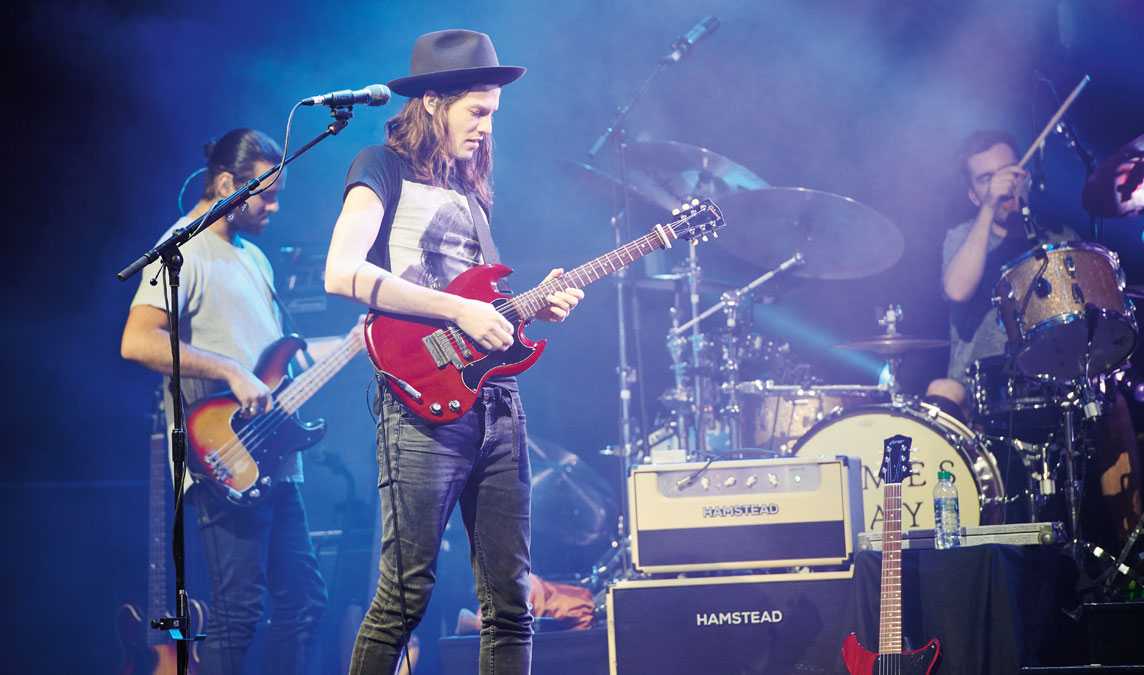
Still got the blues
The noise James Bay makes with a guitar is unique. His clean-to-mid-drive hollowbody tones have their roots in classic rock ’n’ roll, blues and soul, yet they sit perfectly in his contemporary pop songs.
Perched opposite and strumming out some open chords on either of his main Epiphone Century models, one thing is immediately apparent: is that down a whole step to D?
The whole thing is tuned a tone down because I like open chords; C, G. But, I sing better in Bb than I do in C
“Yeah, the whole thing is tuned a tone down,” he confirms. “Why? Well, because I like open chords; C, G and I like all those kinda sus-type moves [Bay demonstrates some standard, country-style G to C progressions]. But, I sing better in Bb than I do in C, meaning I can reach more notes in Bb. The same goes for D and Dm as opposed to E and Em. Those guitar keys - E and A - they’re great, I love ’em, but I sing better in the other keys.
Presumably that means a different setup on the guitars? “Yeah, I’ve got heavier strings on here of course [including a wound G]; 0.012s at the lightest and some are 0.013s, so I’ve still got all of the tension and something to fight with - I like that. I dunno, there’s something immediately cool about it. Everyone who plays guitar with the drop D, it’s really dark and such a great sound, but now I get to do it all the time.
“I actually started tuning down like that when I really started getting into songwriting,” he continues. “As a kid I was just playing the guitar and that’s all that I cared about, but when I started writing songs… I mean I remember playing along to stuff like Van Morrison, early Stones stuff, Carole King… there was a lot of stuff in these higher keys.
“So I was messing around with covers of songs by people like that and I was inspired enough to want to write my own stuff. About 17 or 18 was when I started to tune down, and then by 19 or 20, everything I got was tuned straight down and set up for it; y’know change the neck tension and all that.”
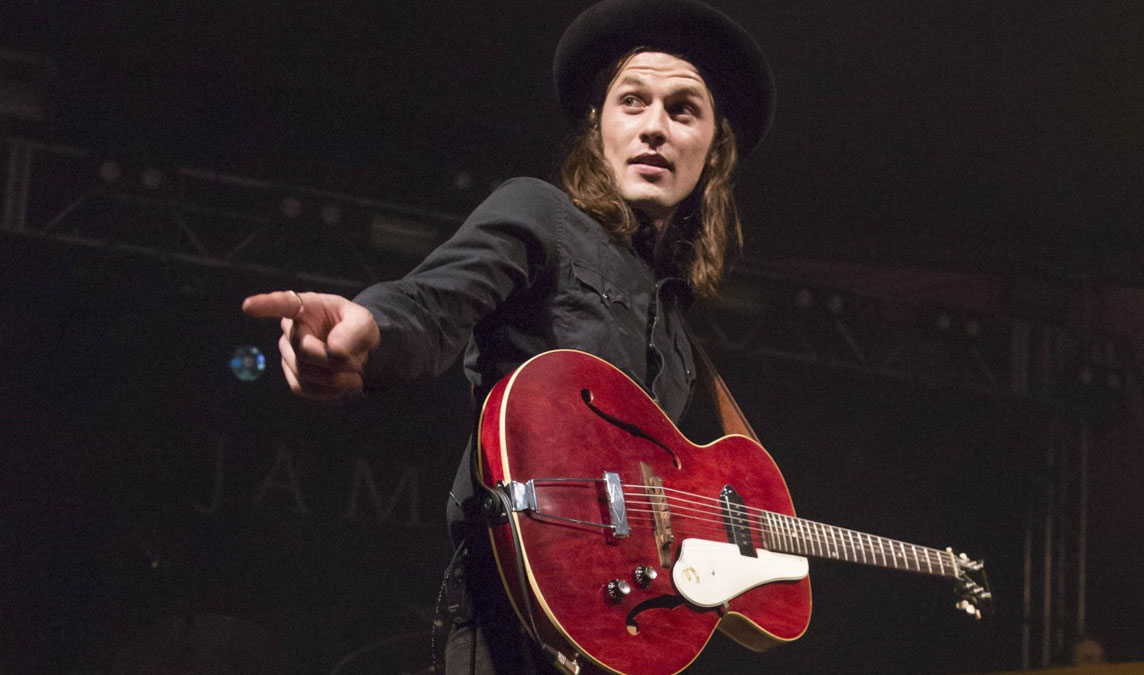
21st century boy
The Epiphone Century guitar he plays isn’t the most obvious choice of instrument for a young singer-songwriter, but James is a big fan of these unusual models.
“This is the first one that I got,” he says, gesturing to the model you see him with most of the time. “It’s a ’66, and then I found the ’65 [a brown model with two pickups], and they’re all slightly different.
“Apparently the ’65 genuinely came like this with the Bigsby, the other P-90 and the different scratchplate. I thought I’d find as many as I could and collect them, but I played a few others that I didn’t get because, well, they were just different.
I play with a lot of energy, and I thought ‘I’ll just treat this like it’s an electric guitar’
“So this one, the main one, I picked up in a guitar shop in New York. I thought, ‘Wow, that’s a cool-looking electric guitar’ and immediately it has the wooden bridge, wound G-string.
“A wound G-string is something you find on an acoustic guitar of course, and older jazz guitars, but generally electric guitars have the plain G and you can bend it as much as you can the B and the E. So immediately there was this argument to be had with the guitar; this fight, y’know and I was really drawn to that.
“At the time, I was really starting to appreciate the sound of Jack White, the sound of people like Dan Auerbach and The Black Keys who really kind of smack it y’know. I play with a lot of energy, and I thought ‘I’ll just treat this like it’s an electric guitar’. No, I can’t get tone or tone-and-a-half bends out of the G-string, but I just like the struggle.
“Obviously these are hollowbody guitars,” he continues. “In fact in the past I’ve recorded them just by mic’ing them up. So there was another benefit to the wound G string; it works like an acoustic guitar.
“Obviously it’s not a big, deep Harmony Sovereign or a J-200 - it’s a little shallow thing - but that’s fun to play with at home. If somebody tells you to shut up because you’re too loud plugged in to the amp, you can soothe things with more of an acoustic sound!”
The guys that transformed blues into pop - Jimi Hendrix, Eric Clapton, Keith Richards, Stevie Ray Vaughan - all those people are a huge inspiration to me
The bluesier side of Bay’s playing is something many people are surprised to hear. Catch him during a mind-in-neutral noodle and he’ll be throwing out BB King and Eric Clapton licks, or soulful chord-melody over Ray Charles changes. What’s the story with that, and how come we don’t hear more of it in his music?
“Blues music and soul, and the phrasing and playing in all of those styles and genres is my core inspiration,” he replies. “It’s where I started; what I started out listening to and focussing in on.
“Then to get ahead and into the music industry and become an artist, I kind of parked all of that and changed direction to really focus in on songwriting. There are all of those inspirations in songwriting, but also I want to be current: I want to be on the radio today.
“So after growing up on blues and soul and rock ’n’ roll, I spent as much time digging into pop, which of course I also loved as a kid. But yeah, blues guitar players, and the guys that transformed blues into pop - Jimi Hendrix, Eric Clapton, Keith Richards, Stevie Ray Vaughan - all those people are a huge inspiration to me because they’re the guys that proved through their music that it’s possible to be both. It sneaks through in my music, but I’ve only released one album, and moving forward there’s going to be more.”
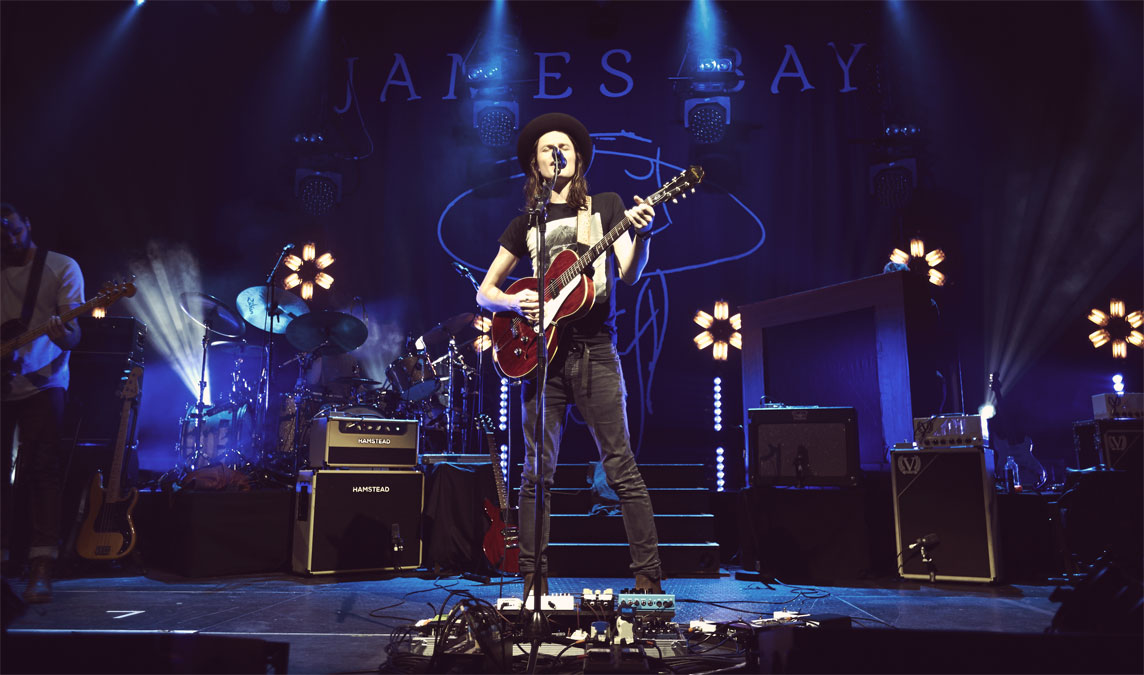
Always forwards
Everyone you talk to will tell you that James Bay is a sincere, friendly and genuine guy. Recently turned 25 and despite his massive success, there’s no sign of unnecessary ego or the big I Am.
Instead we find a gifted songwriter, superb guitarist and exceptional singer whose determination, confi dence and self-belief have him on a trajectory for longevity as an artist. Amid the fight, however, were there moments along the way where he thought it might not happen?
I’ve treated every get-up-in-front-of-people-and sing moment in my life like it’s Wembley
“Like, ‘Will this just end’, do you mean?” he offers with a knowing laugh. “Will I progress beyond open-mics? Will I just have to call it a day? Maybe for a second. Maybe for one second when I was tired, but I think I’ve treated every get-up-in-front-of-people-and sing moment in my life like it’s Wembley. So until I get to Wembley - which will be the greatest day - I will keep treating it like that.” But before that, he has the small matter of writing and recording a second album to think about…
“I’ve been thinking about it since I walked out of the studio from the first record,” he smiles. “Which was way before it was released! Everything I’ve done since making the first record has an effect on how I’ll make the next one. When will I actively do it? I don’t know. Realistically, I’d like to think the end of next year.
“I’ve already got a shed-load of ideas but they’re not formed, really. Just inspiring ideas at the moment. I’m still developing my own thing, mixing colours, and it means that so many more people might listen. I’m excited to push on with that.”
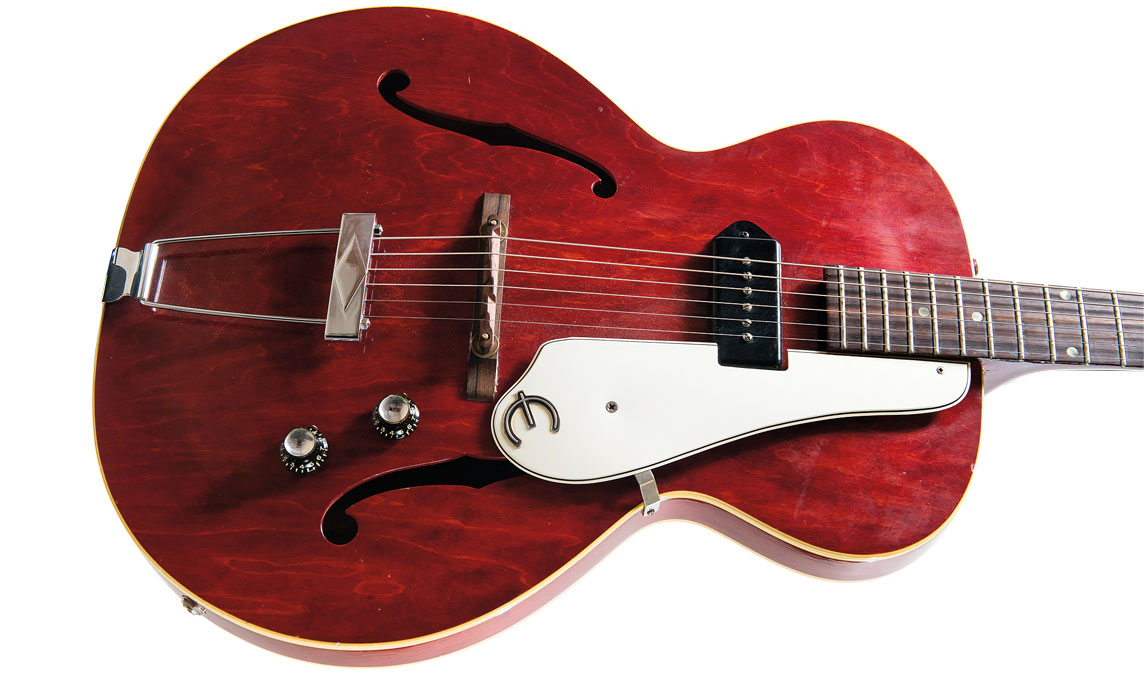
'66 Epiphone Century
This Epiphone Century is James' main guitar. It’s a fully hollow guitar with a wound G string, and is usually tuned a whole step down.
’65 Epiphone Century (not shown)
James’ backup guitar is a brown 1965 Epiphone Century, but it’s quite different from the ’66 model, as it sports dual P-90s and a Bigsby.
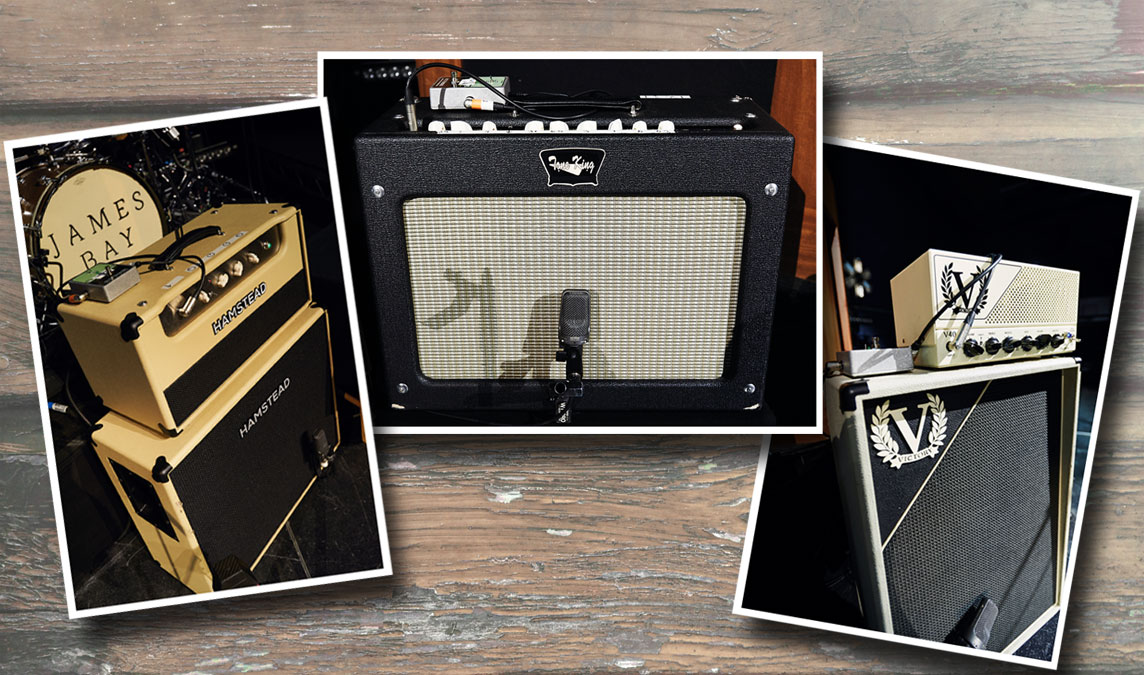
Three amps and the truth
Hot Rod Deluxe tucked away somewhere in the corner? Forget it - Bay’s stage rig begins with a full-on custom-built pedalboard, with signals heading off to three amplifiers for a wet-dry-wet setup.
The main, centre amp is a Tone King Sky King and gets only the overdrive and boost pedals, with the amp’s own tremolo switchable in and out. James then runs a Victory V40 and 2x12 vertical cabinet and a Hamstead Artist 20 in addition.
These amps also get the boost and drive effects, and the various reverbs and delays that are switched in for certain songs.
TheGigRig G2 is the ‘brain’ of the system and handles all routing and switching for amps and pedals, including the various MIDI/ patch changes in the Strymon pedals.
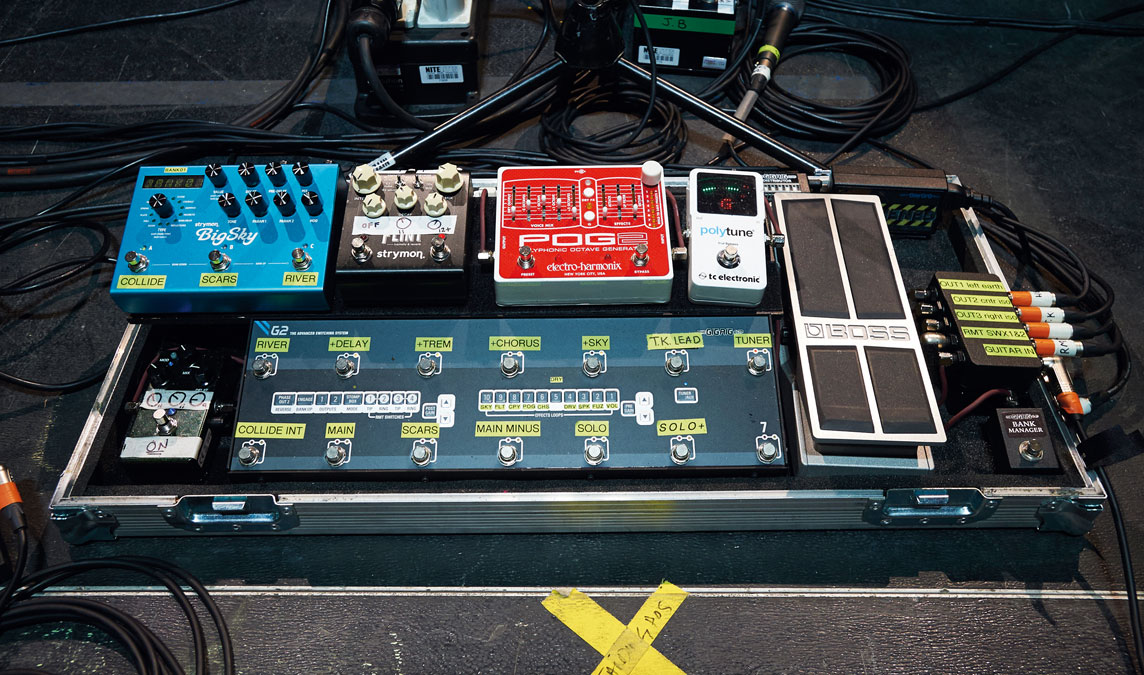
Pedalboards
James has two ’boards, one for his acoustics (below), which runs a pair of TC PolyTunes into a LR Baggs Venue DI, and the main beast above.
His three-amp electric rig is controlled by TheGigRig G2. The effects he uses most often are reverb, tremolo and drive/boost. So, when James had his new board made for touring, on it were a Strymon BigSky and Flint, MXR Carbon Copy, Electro- Harmonix POG2, TC PolyTune and Boss FV-500 volume.
Also on the board are a TC Spark Mini, J Rockett Archer, Crowther Hot Cake and Analogman Bi-Chorus. For tremolo, James uses his Tone King amp, not the Strymon Flint.
